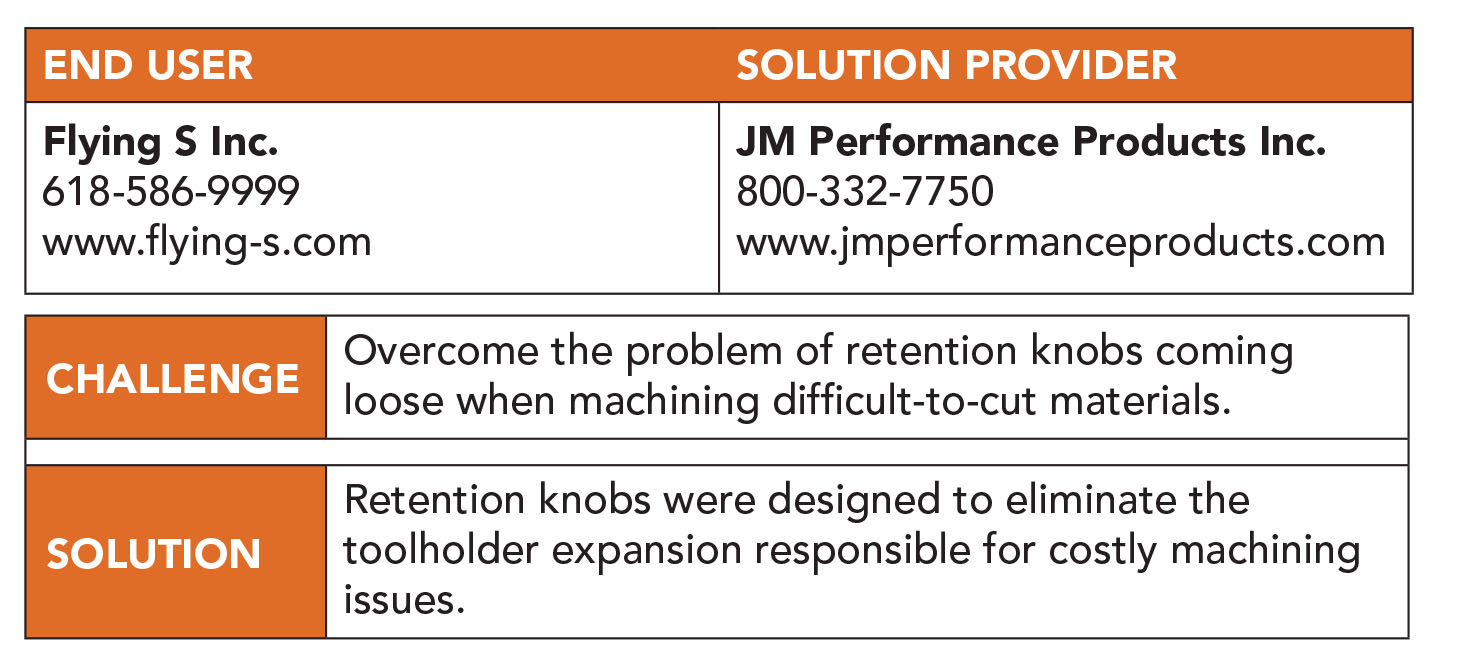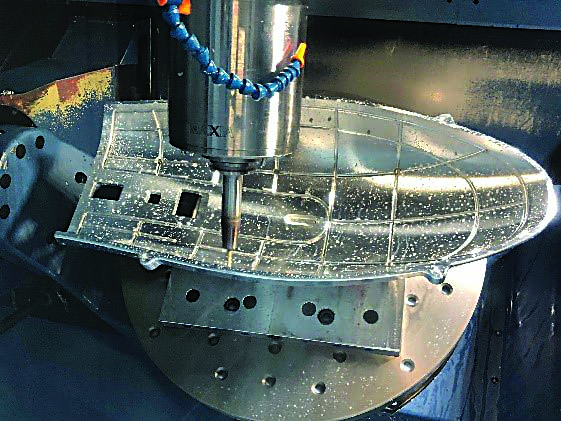More than most industries, aerospace component manufacturers machine a lot of exotic alloys and challenging metals like titanium. A byproduct of using these materials is that more pressure is put on machines, spindles and retention knobs, causing cutting tools to be changed more often as they become dull or break. Tool replacement, not to mention loss of production time due to frequent changeovers, can escalate costs as well.
Founded in 2001, Flying S Inc. in Palestine, Illinois, machines parts for the aerospace industry and has continued expanding with more palletized five-axis machining centers to handle the high volume of complex, tight-tolerance parts made of titanium, stainless steel and other difficult-to-machine materials. Notably, as the five-axis parts that the company made for unpiloted military and civilian aircraft, along with spacecraft, became more complicated, it was clear that greater machine capabilities would be needed to achieve reliable, unattended operation.
“Many of our spaceflight fittings require tight-tolerance features,” said Manufacturing Engineer Peter Bowman. “Our lack of reliable positional accuracy and repeatability due to thermal growth, machine positioning or other variables really took a toll on our efforts to consistently make a good first part and subsequent parts.”
With new five-axis machining centers in place, including models from Matsuura Machinery USA Inc. and Brother Industries Ltd., significantly higher torque and drawbar pressure were being exerted on standard retention knobs, causing issues with the interface between the toolholder and spindle. Standard retention knobs kept coming loose as dimpling and grooving wear patterns repeatedly appeared on the face of knobs, requiring regular replacement.

At a trade show, Bowman witnessed an expanding taper demonstration by Fairport Harbor, Ohio-based JM Performance Products Inc., which featured its patented High Torque retention knobs. They were engineered to eliminate the toolholder expansion responsible for costly, ongoing CNC milling and boring issues. JMPP’s retention knobs feature a relief beneath the precision pilot that forces the threads of the knob deeper into the threaded bore of the toolholder, where a thicker cross section of material resists expansion and deformation.
With the expansion into multiple-axis and unattended operations in full force, Flying S set out to standardize its entire line of CNC machines with JMPP’s retention knobs to overcome catastrophic failure because of metal fatigue and other high-load, force-related issues associated with difficult-to-machine materials and long-reach tools.
Today’s CNC mills, such as Flying S’ multiple-axis machining centers, are designed to operate with high drawbar pressure, a large depth of cut, fast tool changes and high feed rates, which place more demand than ever on retention knobs in V-flange holders. Considering that spindle speeds in excess of 20,000 rpm often are required, a unique set of production machining challenges ensues. For instance, vibration and chatter can occur at these high rates of speed, leading to poor surface finishes that need secondary bench operations or result in serious damage to expensive workpieces.
Any one element could impede the effectiveness of the overall process as the tool, toolholder, spindle, column, ways, table, fixturing and workpiece are all part of the interconnected “machining circle” that necessitates stability to achieve optimal results. According to JMPP, retention knobs are the critical connection between a machine tool and a toolholder, and they are the only thing holding a steep-taper toolholder in the machine spindle.
However, the company reports that many machine shops frequently overlook retention knobs, with a greater focus placed on having high-quality machine tools, toolholders and carbide cutters. Then, ironically, these shops break the loop by using standard retention knobs. Some shops go through thousands of tool changes, which means that knobs are subjected to the high pull forces from the spindle’s drawbar. Excessive torque tends to swell the metal around the retention knob, distorting the toolholder and creating an imperfect fit between it and the spindle taper. Additionally, toolholder expansion caused by standard retention knob installation can reduce the toolholder-to-spindle contact by 70% or more.
Nonetheless, an expensive retention knob does not guarantee better performance. JMPP reports that it redesigned the standard retention knob into the High Torque retention knob, which uses the lowest available threads in the toolholder. The pilot portion beneath the knob flange above the threads stabilizes the knob in the toolholder. The High Torque design includes a precision-ground pilot that ensures exact alignment of the knob in the holder during installation.
The company also manufactures all 30- and 40-taper retention knobs, including High Torque knobs, from AISI 9310H material, which offers 40% more tensile strength than the traditional 8620H material.
Deep-pocket drilling of materials, such as titanium, for example, requires more coolant application, which acts like a high-pressure garden hose. This through-spindle coolant, or TSC, runs through a hole in the knob, which allows the coolant to go through the tool to the tip of the drill, helping to achieve heavy cuts at high feed rates while imparting fine surface finishes. It also enables better chip evacuation by forcing chips out of the hole, improving process reliability.

JMPP’s longer length and shorter threads versus standard knobs mean less torque value and more leverage on the holder for high-pressure coolant use with less fretting on the holder or vibration. The coolant holes also have been sized to increase the cross-sectional strength of the knob.
“We use JMPP’s knobs as standard for both TSC and non-TSC applications across the board because there is no need to swap them out when using TSC,” Bowman said. “It’s a safety measure for us. We would rather standardize so that all retention knobs are TSC-capable, thus reducing the chance of trying to run high-pressure coolant on a non-TSC knob and flooding our spindles. What we found is that the knobs handle the force on the holder exceptionally well with no leaks at 1,000 psi (68.9 bar) and no signs of excessive wear.”
With the increased number of multiple-axis machining centers, Flying S has implemented a standardization plan to exclusively use JMPP’s retention knobs. To date, the company has roughly 2,000-plus retention knobs in operation, including small-spindle, high-production five-axis machines — typically with longer tool requirements and robotically loaded — so the retention knobs work extremely hard. Most of Flying S’ tooling is CAT 40, so it is midsized.
“We’ve had no issues as far as I’m concerned and will only use JMPP knobs going forward,” Bowman said.
Machining complex aerospace parts is common, with more companies investing in multiple-axis machining centers that can match the demanding production challenges. By using more than 2,000 High Torque retention knobs, every tool on Flying S’ machines helps reduce machine downtime, extend tool life and increase profit margins.
“We were finding ourselves replacing the older $11 knobs on a regular basis,” Bowman said. “However, I have never replaced a single JMPP knob. Our standardization investment is great, and I think it will last. We had no idea how much our ‘economy’ retention knobs were costing us.”
Contact Details
Related Glossary Terms
- alloys
alloys
Substances having metallic properties and being composed of two or more chemical elements of which at least one is a metal.
- boring
boring
Enlarging a hole that already has been drilled or cored. Generally, it is an operation of truing the previously drilled hole with a single-point, lathe-type tool. Boring is essentially internal turning, in that usually a single-point cutting tool forms the internal shape. Some tools are available with two cutting edges to balance cutting forces.
- centers
centers
Cone-shaped pins that support a workpiece by one or two ends during machining. The centers fit into holes drilled in the workpiece ends. Centers that turn with the workpiece are called “live” centers; those that do not are called “dead” centers.
- chatter
chatter
Condition of vibration involving the machine, workpiece and cutting tool. Once this condition arises, it is often self-sustaining until the problem is corrected. Chatter can be identified when lines or grooves appear at regular intervals in the workpiece. These lines or grooves are caused by the teeth of the cutter as they vibrate in and out of the workpiece and their spacing depends on the frequency of vibration.
- computer numerical control ( CNC)
computer numerical control ( CNC)
Microprocessor-based controller dedicated to a machine tool that permits the creation or modification of parts. Programmed numerical control activates the machine’s servos and spindle drives and controls the various machining operations. See DNC, direct numerical control; NC, numerical control.
- coolant
coolant
Fluid that reduces temperature buildup at the tool/workpiece interface during machining. Normally takes the form of a liquid such as soluble or chemical mixtures (semisynthetic, synthetic) but can be pressurized air or other gas. Because of water’s ability to absorb great quantities of heat, it is widely used as a coolant and vehicle for various cutting compounds, with the water-to-compound ratio varying with the machining task. See cutting fluid; semisynthetic cutting fluid; soluble-oil cutting fluid; synthetic cutting fluid.
- depth of cut
depth of cut
Distance between the bottom of the cut and the uncut surface of the workpiece, measured in a direction at right angles to the machined surface of the workpiece.
- fatigue
fatigue
Phenomenon leading to fracture under repeated or fluctuating stresses having a maximum value less than the tensile strength of the material. Fatigue fractures are progressive, beginning as minute cracks that grow under the action of the fluctuating stress.
- feed
feed
Rate of change of position of the tool as a whole, relative to the workpiece while cutting.
- gang cutting ( milling)
gang cutting ( milling)
Machining with several cutters mounted on a single arbor, generally for simultaneous cutting.
- grooving
grooving
Machining grooves and shallow channels. Example: grooving ball-bearing raceways. Typically performed by tools that are capable of light cuts at high feed rates. Imparts high-quality finish.
- milling
milling
Machining operation in which metal or other material is removed by applying power to a rotating cutter. In vertical milling, the cutting tool is mounted vertically on the spindle. In horizontal milling, the cutting tool is mounted horizontally, either directly on the spindle or on an arbor. Horizontal milling is further broken down into conventional milling, where the cutter rotates opposite the direction of feed, or “up” into the workpiece; and climb milling, where the cutter rotates in the direction of feed, or “down” into the workpiece. Milling operations include plane or surface milling, endmilling, facemilling, angle milling, form milling and profiling.
- relief
relief
Space provided behind the cutting edges to prevent rubbing. Sometimes called primary relief. Secondary relief provides additional space behind primary relief. Relief on end teeth is axial relief; relief on side teeth is peripheral relief.
- steep-taper toolholder
steep-taper toolholder
Common method of securing the cutting tool body to the spindle in a machine tool. Comes in various styles, including CAT V-flange, British Taper (BT) and ISO.
- tensile strength
tensile strength
In tensile testing, the ratio of maximum load to original cross-sectional area. Also called ultimate strength. Compare with yield strength.
- toolholder
toolholder
Secures a cutting tool during a machining operation. Basic types include block, cartridge, chuck, collet, fixed, modular, quick-change and rotating.



